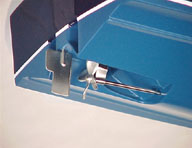The "Power-Vent" Integral Vented Surface Drive System
|
The "Power-Vent" integral vented surface drive is designed for high performance boats. It’s uniqueness is that it can position high efficiency surfacing propeller technology under the hull of a vessel using simplistic, more conventional marine hardware without transom projections and the need to trim shaft angles. The system accomplishes this by configuring a super-cavitating surfacing propeller mounted on a fixed shaft supported by a strut with a stuffing box enclosed within a specially engineered tunnel that is molded into the boat’s bottom. At the forward edge of the tunnel is a short vertical step, which causes the planing wake to occur about 4 feet ahead of the transom. Since the propeller is located completely under the hull within the tunnel, air is introduced to over come other wise detrimental water flow to the prop that would occur. The air allows the planing wake to happen at the vertical step for true “surfaced” operation. Air is provided via two ducts running longitudinally either side of the propeller tunnel. The demand of the spinning propeller acting like a fan, and the flow of water ejected from of the prop tunnel causes air to be sucked in through vents in the transom, and delivered through these ducts to in front of the propeller. The engine’s exhaust is also discharged into this region ahead of the propeller, which is ejected out in the prop wash, resulting in reduced noise, smell and soot.
The ceiling of the tunnel slopes gently towards the front acting like a
baffle to direct thrust forwards when reversing, resulting in good
reverse authority. Steering is accomplished by a balanced rudder
situated aft of the propeller which provides a quick high-speed steering
response. For single engine applications, docking maneuverability is
enhanced with a bow thruster.
Thie Power-Vent surface drive is a non articulating or fixed design that provides
it self with the correct amount of immersion of the propeller through
its vents and ducts. The ambient water level acting like a valve on the
vent opening automatically regulates the volume of air entering the prop
tunnel. The greater the boat’s speed the greater the need for air in
front of the prop. As the boat accelerates and begins to lift, the water
level over the vent opening begins to drop. This allows the flow of air
to gradually increase until the craft has reached full planning at which
time this duct opening is now fully exposed allowing maximum airflow. At
slower speeds this “water valve” creates a restriction in the
airflow, which again causes the correct amount of prop emersion to
prevent over revving and excessive cavitation. What this ability allows
is the boat and the propulsion unit to work together as a system,
providing the capacity to produce a given speed for a given engine rpm.
A craft is able to remain at any of the transitional speeds with proper
loading of the engine. |

|